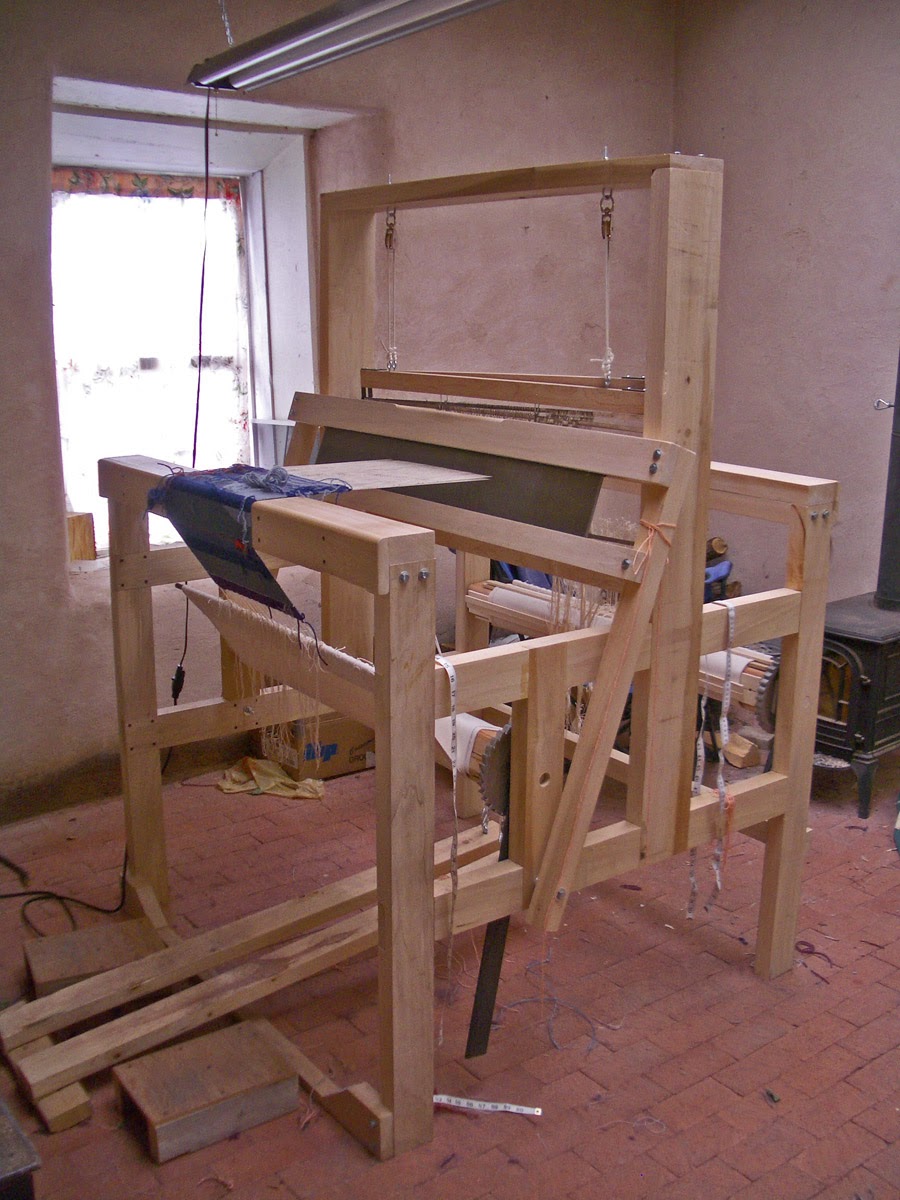There are many kinds of looms that can be used to weave tapestry. Virtually any structure that can hold a set of warp threads in order and taut will work in some fashion. Kids weave them on cardboard boxes all the time.
But for a good tapestry loom, you want something that can hold a relatively high tension. And this is not true of all looms and not even of all looms sold as tapestry looms. Looms for tapestry come in two varieties. There are low-warp looms in which the warp runs more or less parallel to the floor and high-warp looms where the warp runs perpendicular to the floor.
 |
| For the fascinating ATA educational article by Lyn Hart about Sylvia Heyden and her work, click HERE |
The loom I use the most for tapestry is a low-warp countermarche loom made by Harrisville Designs in New Hampshire, USA. This loom was designed with Peter Collinwood and has a worm gear and a warp extender. These features mean the tension is infinitely adjustable and the tension is also even.
 |
| Harrisville Rug Loom, Harrisville Designs |
Counterbalance looms work well for tapestry. My favorite variety, the Rio Grande walking loom, is popular in the American Southwest. They came to this continent with the Spanish and the Hispanic people of New Mexico and neighboring states use them still. They are called walking looms because you stand on the treadles as you weave to shift the shed.
 |
| Rio Grande walking loom |
 |
| Macomber jack loom in the factory |
 |
| This photo came from this website: http://tapestrytour.blogspot.com/2013/02/aubusson.html. Please visit for more information. |
The diagram below shows you the major differences between the kinds of floor looms.
Counterbalance and countermarche looms work like the diagram on the left. Countermarche looms have a more complicated lamm mechanism that allows uneven numbers of harnesses to be raised or lowered at the same time (thus you could do a 3-1 twill for example). Counterbalance looms work with a roller system and when half of the harnesses go up, the other half must go down. Since tapestry is essentially a plain weave, either loom works.
Jack looms work like the diagram to the right. The harnesses are "jacked" up to create the shed. Sometimes the resting position does not have the warp running straight between front and back beams. The jacks actually push the warp down somewhat at rest. For tapestry, if you raise the tension on these looms, the warp pushes the jacks up and you don't get a shed at all.
 |
| Source: Broudy, E. (1979). The Book of Looms. New York: Van Nostrand Reinhold Company. |
 |
| Source: Broudy, E. (1979). The Book of Looms. New York: Van Nostrand Reinhold Company. |
Stay tuned for the next post with information about high-warp tapestry looms.





Very helpful! I'll be back to reference this post for sure.
ReplyDeleteEspecially for that combination jack, counterbalance, countermarche loom, eh?
DeleteVery Interesting! I feel a need to revisit tapestry weaving!
ReplyDeleteNice post, very thorough. The diagrams are so clear. I have a Norwood jack loom--it's the smaller workshop loom that folds--and I've wondered if I can get the tension needed; probably not.
ReplyDeleteThose are nice looms. It would be worth a try. If you have a warp on it that is strong, try increasing the tension a lot and watching to see if the jacks ride up. Try making a shed. You may have to put on a tapestry warp to know for sure
DeleteGreat & thoughtful roundup! Hoping your high-warp post will help me figure out how to warp my newest acquisition, but also now I really need to start brainstorming my low-warp Aubusson build... Never Enough Looms.
ReplyDeleteI don't know how helpful I'll be with warping the high-warp loom (I have only experience with my old Leclerc Gobelin style), but I am so curious about the Aubusson loom build! I think that is a path worth pursuing... I would love one and somehow it didn't occur to me to consider making one myself.
DeleteSo is the Mirrix loom a high warp?
ReplyDeleteI think most people would classify the Mirrix and all small tapestry looms that are basically frames with or without tensioning as a high-warp loom. They certainly work the same, just on smaller scale. Mirrix has made a 48 inch wide loom, so that isn't even so small!
DeleteI'm Lyn Collins
ReplyDeleteHow do you keep from getting a sore neck and do you have a treadle gate to keep the shed open on your low warp?
I had problems with my neck/shoulders and my leg getting tired holding the shed open. I got a Mirrix maybe as I get more acquainted with the process I will be able to switch back to my floor loom.
Ergonomics are always an issue with any hand-craft. The low warp loom just presents different issues than a high-warp loom. On a low warp, you're correct, you have to be careful about your neck and make sure your bench is correctly positioned for your body size. High-warp looms present different issues with reaching up and forward. Some people's bodies do better with one or the other. The occupational therapist in me just cautions as usual to make sure to take frequent breaks (5 minutes off the loom every 25 minutes), make sure to stretch, stay active, and pay attention to your body. (I teach a whole class on ergonomics--maybe I should do some YouTube videos about it.)
DeleteI don't have a treadle gate for the Harrisville rug loom, but they make one and I need to buy one one of these days. I have the treadles doubled so I can use the treadles closest to wherever I'm working AND I have boxes beside the treadles so whichever foot is not pushing the treadle is resting at the same height. Letting your legs dangle on a high bench like the Harrisville has is a bad idea. Of course if you were weaving cloth you'd be shifting the treadles with both feet frequently so they are both resting on the treadles all the time. The Cranbrooks have treadle locks. I don't know about the Glimakra looms.
I do switch back and forth as I do my sampling on a Mirrix. I find the change in position is good for me and I don't think it is a bad idea to try both kinds of weaving and even weave on both kinds of loom from time to time.
Thanks
ReplyDeleteThe Glimakra doesn't have a treadle gate. If I'm doing rugs I normally just tie up two shafts on the countermarche -action is really easy.
I usually rest my feet on the bottom cross piece. I'm hoping as I get more familiar with manipulating the weft I won't have to hold the shed open so long and my legs might not get so tired.
I think I might try a smaller tapestry on the Baby Wolf. I know you don't get a really big shed with a tight warp but then the shed on the Mirrix isn't all that large either.
If I behave and don't hunch -my neck might not get so bad either.